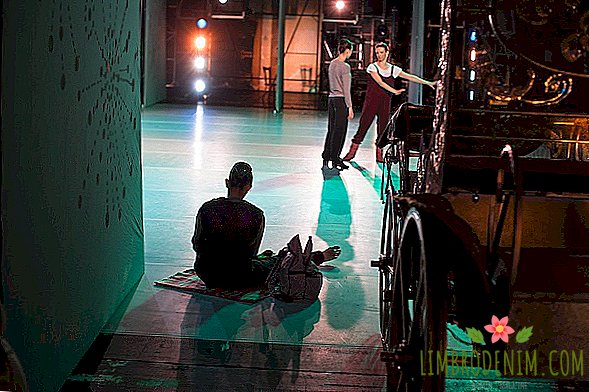One day with the first ballet soloist
The work of a ballerina is one of the most romanticized, where high art and the pain of overcoming go hand in hand. The first associations with her are bandaged legs, endless rehearsals, a strict diet and, at the same time, outfits of impossible beauty and inhuman grace. All this together creates a portrait of a not very earthly being and therefore raises even more questions mixed with admiration. To solve them, we spent the whole day with the soloist of the Moscow Academic Musical Theater. KS Stanislavsky and V.I. Nemirovich-Danchenko, as well as the leading actor in the ballet "Cinderella" Valeria Mukhanova.

The service entrance to the Moscow Academic Musical Theater named after KS Stanislavsky and V.I. Nemirovich-Danchenko (MAMT) is located in a narrow street that goes to Bolshaya Dmitrovka. Then everything is more complicated: after the checkpoint, you can stick into the elevator without a hint of navigation or go to the stairs, which is not typical of the linearity of the route. Fortunately, in the elevator I was lucky to meet a stately and deadly calm man, who suggested that the ballet rooms are located on the fifth floor. From this point on, I involuntarily draw on a string: by the end of the day I would like to go like that forever, but ideally I would go back fifteen years ago and not throw a circle of dances.
The fifth floor, like any other in the building, is a short corridor with many branches at the end, which somehow permeate the building. There are women's and men's dressing rooms, rehearsal rooms and a huge workshop for the preparation of scenery. Valeria quickly takes us through it, noting with regret that the ballet was hoping to grab this bright hall for rehearsals, but now it is cut out of foam plastic, glued and sewn everything that the viewer sees from the hall.
Lera, as she asks herself to be called, works at MAMT for seven years - she came here immediately after the Natalia Nesterova Academy, where she studied, like regular schoolchildren, for 11 years. Dancing came into her life before the ballet: at the age of five, her parents preventively gave her to the studio so that the girl would not waste time on bad companies. “No one in my family dances, so at first my parents thought about artistic or artistic gymnastics, but then they stopped at something average,” she said. There, teachers saw the talent and advised parents to send the child to the ballet. It can be said that a ballet dancer's career began at the age of 7: while her peers devoted 5-6 hours a day to their studies, future ballerinas spent most of the day at the academy, alternating mathematics and Russian lessons with morning and afternoon rehearsals.



"Despite the fact that I studied in a specialized institution, none of my family took my ballet perspective seriously until I went to the theater. This is not surprising, because of all my classmates, it seems I alone became a ballerina. Not because the rest were not capable. My good friend with perfect data graduated and decided to build a family instead of a career, so now she is a mother of beautiful children, "Lera says.
It is impossible not to ask a question about a career after childbirth - such a serious and lengthy test as pregnancy, it would seem, should not pass without a trace for the organism, which always needs to be strong and flexible. Lera replies that, of course, most female artists return to the theater, and pregnancy does not mean the end of a career: "Everything depends on the organism, its ability to regenerate and desire. But it seems to me that real life and theater are difficult to combine: we all get here right after study, we spend a lot of time together and we constantly learn. Nobody thinks about the age of the people with whom he communicates, and because of this it seems that time in the theater is flowing in a special way, it affects you and gives the character some infantilism. "
Frivolous, however, the work of a ballerina can not be called. Every day at 11 am, an exercise begins, that is, a warm-up of all muscles. It lasts just over an hour, and then, as a rule, artists begin rehearsals for the current repertoire. It so happens that the dancer is not busy in the nearest performances and she has a lot of free time after the morning workout. Everyone controls them in his own way, more often everyone rehearses independently, but the theater management has the right to let the artist go to third-party performances or tours, so he can earn experience, money and not spend time in vain.






"We have a demanding job, she, as my teacher at the academy said, does not tolerate competition with anything. This is true: the day routine is completely subordinate to training, so you can really get tired even in the morning after a serious rehearsal. And we have weekends on Tuesday, so spending time with non-ballet friends on Saturday is also difficult. But sometimes, of course, you need to rest. With moral fatigue it helps me to abstract from ballet for a day, during which time it turns out to reboot. I like to draw and now often draw Ayu - while there is only enough time for self-study. "
On the question of whether it is fraught to leave training for the whole day, Lera replies that you need to listen to your body and give it rest, if necessary. When she first came to the theater, she, like any beginning ballerina, relied on the coach’s help: they don’t indicate, but they share more experience that the young artist still lacks. There are a few teachers at MAMT: five women and three men for more than 100 soloists and ballet dancers. Moreover, men train men, women - women. "Male and female dance differ. Boys have more jumps and power elements, because they do not dance on pointe, and girls, I would say, are jeweler. We care about hands, feet, and in general we are more about nuances," Lera explains .
On the day before the performance, she does a little bit: the dress rehearsal, where the entire performance was chased, took place yesterday, and today we must try to accumulate strength. The conductor of the performance comes to a short rehearsal after the performance and, together with several artists, chases away the difficult moments for them. Something that soloists are asking to play faster, the other - slower. "Yes, of course, it would be better to dance at the pace in which the score is written, but sometimes it is too difficult to move. Ballet is an art, of course, but it's great that we are all human and can agree," explains Lera after the rehearsed "turntables".






The next day we meet three hours before the concert - this time is enough to put on make-up, make hair and rehearse the most difficult thing on stage. By this time, Lera was already warming up. She is wearing warm clothes and funny chuni, which all soloists wear after morning rehearsals, which is why the corridors are filled with pretty shuffling. Clothing allows the muscles to cool down before the start of the performance, so Lera is sent to the dressing room in sweat pants and waistcoat.
The room where beauty is suggested is similar to the ordinary barber shop of the border zero: warm light, rows of chairs opposite the mirrors and tons of cosmetics and wigs. Several make-up artists and hairdressers work for the whole theater, all of them are women of different ages and, apparently, hobbies. On one makeup and haircut takes about an hour, a lot of work, so the masters can only talk with ballerinas. Everywhere I hear small talk: "He asks me if I can have a cake. Yes, I eat more than my mother, of course, I can." Discuss costumes.
In the hairdresser's chair, Lera pulls out a cosmetic bag with chignon - he won't need it today - and looks at the box with sparkling pins and tiaras. Crown choose about fifteen minutes: "I do not want as a tree." It is necessary that the tiara was beautiful, but not too rich and combined with a hairpin, which holds the hair behind. After her hair is combed, collected in a smooth bun, and the side strands are curled in boucle, Lera sits down to the make-up artist. Make-up is done faster: it is clear that for certain roles it is more or less the same. Cinderella does not need, like fairies, to whiten the face and draw it again, so the make-up artist quickly draws black angular Smoky eyes, using a familiar movement, measures the necessary centimeters from the half-meter tape of false eyelashes and emphasizes eyebrows. The beginning of the seventh, Lera just has time to get rid of something right on the stage.






The backstage scenes are huge, booming and seem to go up to nowhere. It is already half-dark here, because the electricians adjust the light: only behind the curtains it becomes clear how complex all the light circuits, which during the performance are perceived as something that goes without saying. Peacock, chess pieces, twisted carriages - at dusk the scenery, which are arranged here, looks even more magnificent. In addition to them, a props like fans, which the soloists will need, are laid out, and a pallet with rosin is installed, in which the pointe shoes and Czech shoes are periodically lowered. Almost everything is already in the costumes and in the workout on top of them, the loudspeaker threatens that the performance will not start until the make-up is completely ready (an invisible voice appeals to men for some reason).
Gradually, the scenes are filled with chirp and bustle: girls with veiled faces rehearse the gait, the fairy glittering from head to foot thumps on a free piece of floor and begins to bend the legs unnaturally, this time in lacquer shoes and costume, smacking with soloists and with someone that talks. Periodically, someone runs up to the sound engineer booth and runs his hand in a package with nuts. With the approach of seven o'clock, the sound engineer is more and more commanding and even rightly swears at someone: "Sergei, you should put a sign on such performances for the most stupid that you can't go there." Five minutes after seven, it finally works: the first soloists quickly go on stage, small bustle calms down until they return, breathing noisily. Behind them, other parties of artists leave and return, and so for several hours with a break for a short intermission.
The gap between the scenery, from where you look at all the action, is periodically blinded by spotlights and the reflections of the dresses, and people who are not dressed like Muggles skip past. Here you can hear backstage conversations, unfunny jokes and complaints, and at this moment you realize that, despite its inaccessibility, ballet dancers are real people who simply work very hard. They also doubt, worry and fear, but they work so hard that for many human weaknesses there is often no place in their head or time. And it is this that will always distance them from all the others and give the ballet that veil behind which the audience comes to the theater.











Photo: Yegor Slizyak





